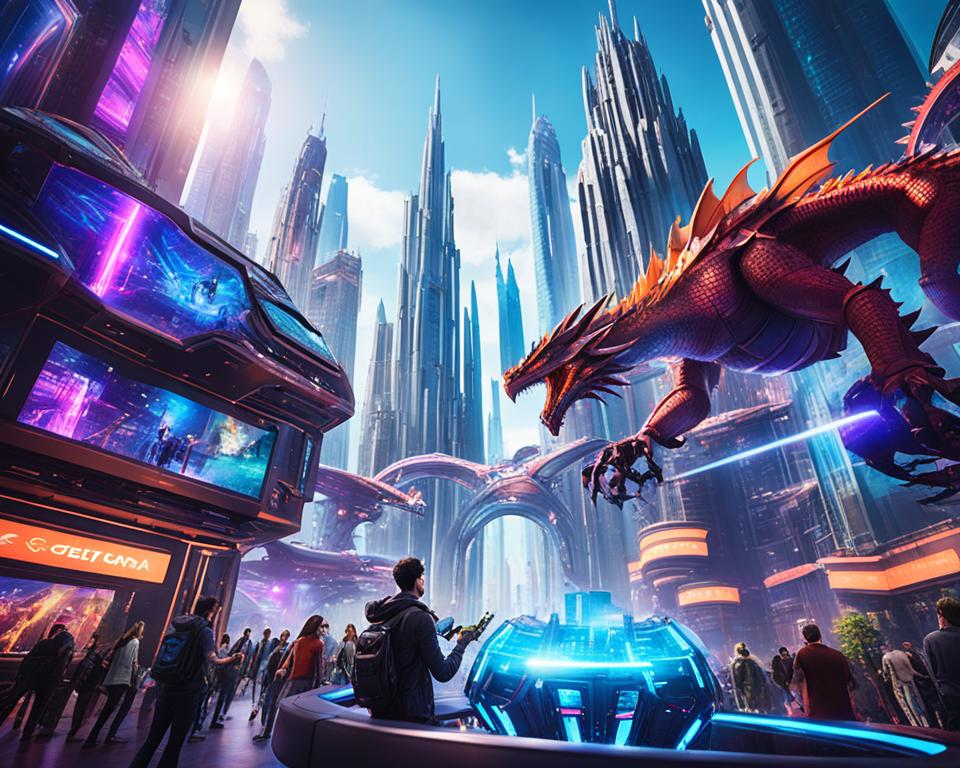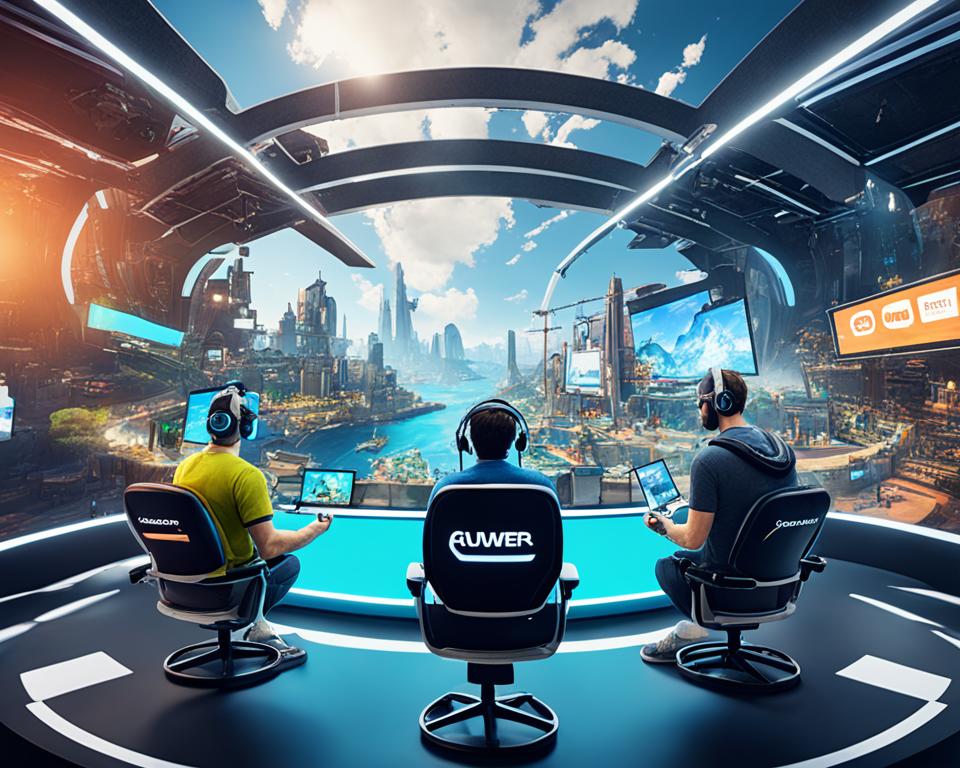Welcome to an exciting exploration of the dynamic world of games and technology. In this article, we will delve into the innovative advancements that have revolutionized the gaming industry and transformed the way we experience video games and online gaming. Prepare to be captivated by the cutting-edge tech advancements that have propelled digital entertainment to new heights.
From the early days of gaming consoles to the immersive experiences of virtual reality and the rise of competitive online gaming, the intersection of games and technology has reshaped the way we play and connect with others. As technology continues to evolve at an astonishing pace, we find ourselves on the cusp of a new era in gaming.
Throughout this article, we will explore the evolution of gaming and how it has evolved from pixelated graphics to mind-blowing virtual realities. We will discuss the profound impact of artificial intelligence (AI) on game design, the integration of augmented reality (AR) and virtual reality (VR) in gaming, and the drive toward ultra high-definition gaming experiences.

Not only will we dive into the mesmerizing advancements, but we will also examine the economics of gaming and the balance between accessibility and technological advancements. Furthermore, we will explore the emerging technologies that are shaping the gaming industry, such as Web3 and blockchain, and how they are fostering a global gaming community.
Prepare to embark on a thrilling journey through the realm of games and technology, as we uncover the fascinating innovations that continue to propel the gaming industry forward. Get ready to immerse yourself in the future of gaming!
The Evolution of Gaming: From Pixels to Virtual Realities
In this section, we will delve into the fascinating evolution of gaming, tracing its journey from the early days of pixelated graphics to the immersive experiences of virtual reality. The gaming industry has undergone remarkable transformations, driven by technological advancements and digital trends that have shaped the way we play and interact with games.
From the humble beginnings of arcade machines and home consoles, gaming has progressed exponentially, embracing new technologies and pushing the boundaries of what was once thought possible. As computing power grew, game developers were able to create more complex and visually stunning worlds that captivated players.
The emergence of 3D graphics was a pivotal moment in the evolution of gaming. It brought game worlds to life, offering players a new level of immersion and interactivity. With improved graphics capabilities, games became more visually appealing, allowing players to explore detailed environments and engage with lifelike characters.
But the evolution didn’t stop there. The introduction of virtual reality (VR) revolutionized the gaming experience once again. VR technology enables players to step into virtual worlds and interact with them in ways never before imagined. It provides an unprecedented level of immersion, making players feel like they are truly part of the game.
Game development has also seen significant advancements. Developers have access to powerful tools and engines that allow them to create intricate gameplay mechanics, sophisticated AI systems, and compelling narratives. The rise of indie game development has sparked creativity and innovation, diversifying the gaming landscape and giving players a wide range of unique experiences to choose from.
Digital trends have played a crucial role in shaping the evolution of gaming. The rise of online gaming and multiplayer experiences has transformed gaming into a social activity, connecting players from around the world. Esports has gained tremendous popularity, turning gaming into a competitive sport and creating opportunities for professional players.
As gaming continues to evolve, we can only imagine what the future holds. The possibilities are endless, with emerging technologies such as augmented reality (AR), cloud gaming, and artificial intelligence (AI) poised to redefine the gaming landscape once again. It’s an exciting time to be a gamer, as we witness the convergence of technology and entertainment, creating new and immersive gaming experiences.
Redefining Interaction: AI’s Role in Modern Video Games
In the ever-evolving world of video games, artificial intelligence (AI) has emerged as a powerful force, revolutionizing the way players interact with virtual worlds. AI’s ability to simulate human-like behavior and decision-making has led to the creation of dynamic and immersive gaming experiences. This section will delve into the various aspects of AI in video games, including the emergence of AI characters and non-player characters (NPCs), the integration of AI in game design, and the impact it has on PC hardware.
The Emergence of AI Characters and NPCs
One of the most notable advancements in modern video games is the inclusion of AI characters and NPCs. These virtual entities are designed to interact with players, offering a lifelike and believable experience. AI characters can serve as allies, enemies, or companions, adding depth and complexity to gameplay. NPCs, on the other hand, populate the game world, providing quests, information, or simply enhancing the overall atmosphere. The use of AI characters and NPCs enhances immersion and creates a more engaging gaming experience.
Programming Thought and Learning in Game Design
Game designers utilize AI technology to create intelligent, adaptable, and responsive game environments. By programming thought and learning algorithms into NPCs and AI characters, game designers can create dynamic and evolving gameplay scenarios. This allows for tailored experiences based on the actions and choices made by the player. The incorporation of AI in game design opens up a world of possibilities, where games can adapt and respond to player behavior, creating unique and personalized experiences.
AI and the Demand on PC Hardware
The implementation of AI in video games brings with it an increased demand on PC hardware. The complex calculations and processing required to simulate human-like behavior and decision-making can put a strain on a player’s computer system. High-performance CPUs and GPUs are necessary to handle the computational load of AI algorithms, ensuring smooth gameplay and realistic AI interactions. As AI continues to advance and push the boundaries of gaming, PC hardware will need to keep pace to meet the demands of modern gaming experiences.
Breaking Boundaries: The Integration of AR and VR in Gaming
In recent years, the gaming industry has witnessed a revolution with the integration of augmented reality (AR) and virtual reality (VR) technologies. These advancements have opened up new possibilities and are breaking boundaries, creating immersive gaming experiences like never before.
AR technology overlays digital elements onto the real world, enhancing the player’s environment and blurring the line between fiction and reality. Imagine battling virtual creatures in your living room or solving puzzles in a virtual escape room set in your own home. With AR, games come to life in a whole new way, offering interactive and dynamic experiences.
On the other hand, VR technology transports players to entirely virtual worlds, immersing them in environments that feel so real, they forget they’re in a game. From exploring ancient ruins to piloting spacecraft, VR allows gamers to experience adventures firsthand, completely submerging themselves in a virtual realm.
AR and VR have revolutionized gaming experiences by providing a level of immersion and interactivity previously unimaginable. These technologies offer a unique sense of presence, making gamers feel as if they are truly part of the virtual world. Whether it’s fighting off zombies in an apocalyptic landscape or building a virtual world from scratch, AR and VR enhance gameplay and transport players to new dimensions.
Moreover, the integration of AR and VR has expanded not only the possibilities for gaming but also its diversification. Developers are creating new genres of games that leverage these technologies, such as location-based AR games and multiplayer VR experiences. The boundaries of traditional gaming are being pushed, allowing for innovative gameplay mechanics and interactive storytelling.
As AR and VR technology continues to advance, we can expect even more groundbreaking gaming experiences to emerge. The integration of these technologies opens up a world of possibilities, where reality and fantasy blend seamlessly, and gaming becomes a truly immersive adventure.
Games and Technology: The Drive Toward Ultra High-Definition
In the ever-evolving world of gaming and technology, the pursuit of high-definition visuals and immersive experiences has become a top priority for gamers. The demand for ultra high-definition gaming has led to the widespread adoption of 4K gaming, which offers stunning visual clarity and intricate details that elevate the overall gaming experience.

4K gaming, also known as “Ultra HD gaming,” refers to playing video games at a resolution of 3840 x 2160 pixels, four times the resolution of standard high-definition (1080p) gaming. This increased resolution allows for sharper imagery, vibrant colors, and enhanced graphical fidelity, resulting in a truly breathtaking visual experience for gamers.
The impact of 4K gaming goes beyond just visuals. With its higher resolution, gamers can see finer details, such as intricate textures, realistic lighting effects, and smoother animations, all of which contribute to a more immersive and engaging gaming experience. Whether it’s exploring a vast open world or engaging in fast-paced action sequences, 4K gaming brings games to life in ways previously unimaginable.
The 4K Gaming Experience and Its Impact
4K gaming has revolutionized the way gamers experience their favorite titles. The increased resolution and graphical fidelity make games feel more realistic and immersive. Every blade of grass, every facial expression, and every explosive particle effect comes to life with stunning clarity, transporting gamers into the heart of the virtual worlds they explore.
Moreover, 4K gaming allows developers to create more visually striking and detailed environments. Intricate level designs, lifelike character models, and realistic weather effects can now be fully appreciated, enhancing the overall atmosphere and ambiance of the game world.
For competitive gamers, 4K gaming provides a distinct advantage. With the ability to identify enemies and objects more clearly, players can react faster and make better strategic decisions, ultimately improving their performance in multiplayer games.
Navigating the Cost of High-Performance GPUs
While the benefits of 4K gaming are undeniable, it is important to consider the hardware requirements necessary to achieve the desired visual fidelity and smooth performance. High-performance graphics processing units (GPUs) play a crucial role in delivering the power needed for 4K gaming.
GPUs are responsible for rendering the complex graphics and visual effects in games. To ensure a consistent and enjoyable 4K gaming experience, gamers need to invest in high-performance GPUs capable of handling the demanding requirements of ultra high-definition gaming.
However, the cost of high-performance GPUs can be a hurdle for some gamers. These GPUs often come with a premium price tag, making them less accessible to budget-conscious gamers. It is crucial for gamers to find the right balance between performance and affordability, considering their specific gaming needs and budget constraints.
Fortunately, advancements in technology have led to more affordable options in the GPU market, enabling a broader range of gamers to enjoy the benefits of 4K gaming. Additionally, manufacturers continue to push the boundaries of GPU performance, offering a variety of options to suit different price points and gaming preferences.
Cyber Athletes: The Competitive Landscape of Online Gaming
In today’s digital age, online gaming has evolved into a fiercely competitive arena where the best players rise to the top. The emergence of cyber athletes has transformed gaming from a casual pastime into a professional sport. With the rise of esports, online gaming has taken the world by storm, captivating millions of viewers and offering lucrative career opportunities for skilled players.
Esports tournaments, such as the Dota 2 International and the League of Legends World Championship, showcase the immense popularity and competitiveness of online gaming. These events attract top cyber athletes from around the globe, who compete for coveted titles and million-dollar prize pools. The skills and strategies required to succeed in these tournaments rival those found in traditional sports, highlighting the dedication and talent of cyber athletes.
To excel in competitive gaming, cyber athletes must possess exceptional reflexes, hand-eye coordination, and strategic thinking. They spend countless hours honing their skills, analyzing gameplay, and strategizing with their teams. Just like professional athletes in traditional sports, cyber athletes follow rigorous training schedules and compete in high-pressure environments.
The growth of the esports industry has also seen the emergence of professional teams and organizations. These teams provide support and resources to cyber athletes, enabling them to focus on their gaming careers. Sponsors, brands, and partnerships further contribute to the economic success of esports, creating opportunities for cyber athletes to earn substantial incomes through salaries, endorsements, and streaming revenues.
Furthermore, the success of cyber athletes has led to the recognition of esports as a legitimate industry. Major corporations now invest in esports organizations, stadiums are built specifically for hosting esports events, and media coverage of competitive gaming has reached new heights. The skills and dedication of cyber athletes have transformed online gaming into a global phenomenon, attracting millions of fans and redefining the future of sports entertainment.
| Cyber Athletes | Competitive Gaming | Esports |
|---|---|---|
| Exceptional reflexes | Tournaments and events | Global phenomenon |
| Hand-eye coordination | Professional teams | Million-dollar prize pools |
| Strategic thinking | Rigorous training | Growing popularity |
| Dedication and talent | Economic success | Endorsements and sponsorships |
The Economics of Gaming: Accessibility vs. Technological Advancements
In the ever-evolving world of gaming, two key factors play a crucial role: accessibility and technological advancements. The economics of gaming are shaped by the delicate balance between making games accessible to a wide audience while pushing the boundaries of technology to deliver immersive experiences.
Price of Gaming: Balancing Tech Quality and Affordability
One of the primary considerations for gamers is the price of gaming. As technology advances and new features are introduced, the cost of hardware and software can rise. Gamers often face the challenge of balancing the desire for high-quality tech with the need for affordability.
However, affordability doesn’t mean compromising on tech quality. Game developers and hardware manufacturers strive to create accessible options without sacrificing performance. This allows gamers with varying budgets to enjoy quality gaming experiences.
Another aspect to consider is the total cost of ownership. While high-end gaming systems may have a higher upfront cost, they often provide better long-term value due to their longevity and ability to support future game releases.
It’s important for gamers to carefully evaluate their gaming needs, preferences, and budget to find the right balance between tech quality and affordability that suits them best.
Investing in Scalable Gaming Technologies
Gaming is not just a hobby; it’s also a lucrative industry. With the growing demand for gaming experiences, there are significant opportunities for investors to explore gaming-related ventures.
Investing in scalable gaming technologies can be a smart move, as it allows stakeholders to tap into the expanding market and benefit from its growth. From game development studios to hardware manufacturers, those who invest in gaming technologies stand to gain from the increasing demand for immersive gameplay.
Furthermore, investing in gaming advancements such as virtual reality (VR) and augmented reality (AR) can lead to substantial returns. The rise of these technologies opens up new avenues for gaming experiences and creates opportunities for innovative startups and established companies alike.
By staying informed about the latest trends, identifying promising gaming technologies, and partnering with industry experts, investors can position themselves for success in the dynamic gaming market.

Emerging Technologies: Web3, Blockchain, and the Global Gaming Community
In this section, we will explore the emerging technologies that are shaping the gaming industry. We will discuss the impact of Web3, blockchain, and the global gaming community. From the use of blockchain for transparency and ownership in gaming to the rise of decentralized gaming ecosystems and the power of collaborative play, we will examine how these technologies are transforming the gaming landscape.
Blockchain for Transparency and Ownership in Gaming
The integration of blockchain technology in gaming has brought forth a new era of transparency and ownership. By leveraging the decentralized nature of blockchain, game developers can create secure and transparent systems that allow players to truly own their in-game assets. Blockchain technology ensures that every transaction and modification made within the game is recorded on an immutable ledger, eliminating the possibility of fraud or unauthorized changes. This level of transparency instills confidence in players and establishes a fair and trustworthy gaming environment.
Furthermore, the utilization of non-fungible tokens (NFTs) on blockchain platforms enables the unique identification and ownership of in-game items. Players can buy, sell, and trade these digital assets on blockchain-based marketplaces, revolutionizing the concept of virtual ownership. The ability to prove provenance and authenticity of virtual items enhances their value and opens up new revenue opportunities for players and developers alike.
Decentralized Gaming Ecosystems and Player Empowerment
The emergence of decentralized gaming ecosystems powered by blockchain technology has brought a new level of player empowerment. Traditional gaming models are often centralized, with game developers and publishers exerting significant control over the gaming experience. However, with decentralized gaming platforms, players have greater autonomy and control over their gaming experiences.
Decentralized gaming ecosystems allow players to participate in the decision-making process and shape the evolution of the games they love. By utilizing decentralized governance models, players can vote on game updates, features, and even revenue-sharing mechanisms. This level of community involvement creates a sense of ownership and strengthens the bond between players and developers.
Additionally, decentralized gaming platforms enable the creation and distribution of user-generated content (UGC). Players can showcase their creativity by designing and selling in-game assets, levels, or even entire games. This opens up new avenues for players to monetize their skills and creativity, fostering a vibrant and engaged gaming community.
Collaborative Play in an Interconnected World
Web3 technologies have facilitated the emergence of collaborative play in an interconnected gaming world. With Web3 protocols and blockchain-powered platforms, players can engage in seamless cross-platform gameplay, regardless of the devices or operating systems they use.
Decentralized gaming platforms leverage the benefits of blockchain, enabling players to experience true ownership and value transfer across different games and platforms. Players can bring their assets and progress from one game to another, creating a unified gaming experience and fostering collaboration between game developers.
Furthermore, the use of blockchain-based smart contracts allows for secure and transparent transactions between players. Collaborative game modes, such as guilds, tournaments, and cooperatives, can utilize smart contracts to automate reward distribution and ensure fair gameplay. This enhances the social aspect of gaming and encourages players to work together toward common goals.
In conclusion, the integration of Web3 technologies and blockchain in the gaming industry is revolutionizing the way games are created, played, and experienced. These emerging technologies provide unprecedented transparency, ownership, and empowerment to players, while fostering collaboration and an interconnected gaming community.
Conclusion
Throughout this article, we have explored the exciting intersection of games and technology, delving into the latest advancements in the gaming industry and the impact of technology on online gaming and digital entertainment. From the evolution of gaming, from pixels to virtual realities, to the role of artificial intelligence (AI) in modern video games, we have witnessed the transformative power of technology in shaping the gaming landscape.
One of the key takeaways is the integration of augmented reality (AR) and virtual reality (VR) in gaming, which has broken boundaries and created immersive gaming experiences. The drive toward ultra high-definition gaming has also been a significant focus, with the 4K gaming experience enhancing visuals and gameplay. Additionally, the rise of cyber athletes in the competitive landscape of online gaming showcases the evolution of gaming as a professional sport.
Looking ahead, the future of gaming holds even more possibilities. As emerging technologies such as Web3 and blockchain continue to evolve, the global gaming community is experiencing increased transparency, ownership, and empowerment. Collaborative play in an interconnected world is becoming a reality, opening doors to new gaming experiences and opportunities for players.
In conclusion, the future of gaming is bright and full of technological advancements. As technology continues to shape the gaming industry, we can expect more immersive experiences, enhanced visuals, and innovative gameplay. The interplay between games and technology will drive the industry forward, creating new possibilities for both players and developers alike.

